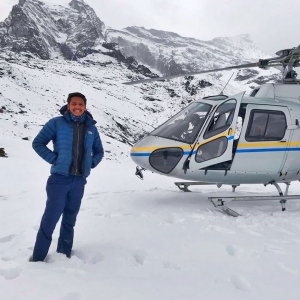”Don’t die without embracing the daring adventure your life was meant to be.” – Steve Pavlina
Yes, exactly and the Nepalese Himalayas are one of them Prime places to explore your adventure Feelings. Many of us have a dream to do dream trekking in Nepal, Everest Base Camp Trek. At the same time, many people get suffered from many problems while doing the trek. Among them, Acute Mountain Sickness or also known as AMS is one of the major problems but it is no big deal if you are aware of it.

What is Altitude Sickness?
Altitude Sickness which is also known as Acute Mountain Sickness (AMS), is a negative reaction of Your Body while you are at a high altitude (Above 2,000m/ 6,561 Ft) caused by Low Oxygen. While we go up in the Mountain, a layer of Oxygen goes slowly less at High Altitudes. It is quite similar to Hangover after drinking but it is a very serious case.
Acute Mountain Sickness (AMS) common symptoms
- Persistent headache
- Poor appetite
- Nausea (feeling sick) and vomiting
- Fatigue (feeling tired)
- Dizziness
- Poor sleep or sleep disturbance (insomnia)
- Disorientation
- Slight swelling of hands and face
.jpg)
Who Suffer from Acute Mountain Sickness?
There is no specific person who may suffer from altitude sickness. There are many cases that even the Nepalese Staffs (Guide & Porter) has suffered from Altitude sickness. You never know who gets Mountain Sickness and it doesn’t become noticeable till you have been at that altitude for a while. The Mystery of High altitude sickness is that it is very tough to predict who will suffer while trekking or getting to High altitude. We have many stories of fit and healthy trekkers being badly affected by Mountain Sickness. BUT at the same time, their older companion has felt fine and successfully done trekking. So that It is very unpredictable
What are the Preventions of Acute Mountain Sickness (AMS)
- Acclimatization: After 1,000m ascent stay one more night for acclimatization
- Do not make a rapid ascent
- No alcohol, no sleeping pills, no smoking, no sex
- Drink more: about 3-4 liters day-clean water (boiled, filtered, or medicated), tea, coffee, soup, and juice
- No heavy backpacks
- Climb higher, always sleep lower
- Ascent less than 300m a day above 3.000m of altitude
- Everyday Drink 3/4 Ltr water
- Eat well and regularly
- Wear proper warm cloth while you are at a high altitude.
- Be aware of wind prevention.
- If you have mild symptoms, do not proceed higher. Take aspirin tablets.
- If you have worsening symptoms, go down immediately.
- Do not leave your team member behind unattended.

- During your trekking time, we very recommend you to walk slowly which is very important. Some people walk in the mountains very fast and they may have very high chances to get altitude sickness. Go up slowly, take it easy and make your breathing slow. You need to have a few extra acclimation days to get used to Altitude. Two things are certain to make altitude sickness very likely - ascending faster than 500m per day, and exercising vigorously.
- Some people use Diamox while trekking or before starting their trek which is very dangerous in the mountains. AND please note that Diamox is not a medicine that protects you from Altitude. It just helps you to don’t feel the altitude in your mind but your body is still suffering. Besides this, most people get vomited from this medicine. That is the way, we very much suggest you avoid Diamox.
Some of the most popular Trips:
Everest Base Camp Trek - 14 Days



